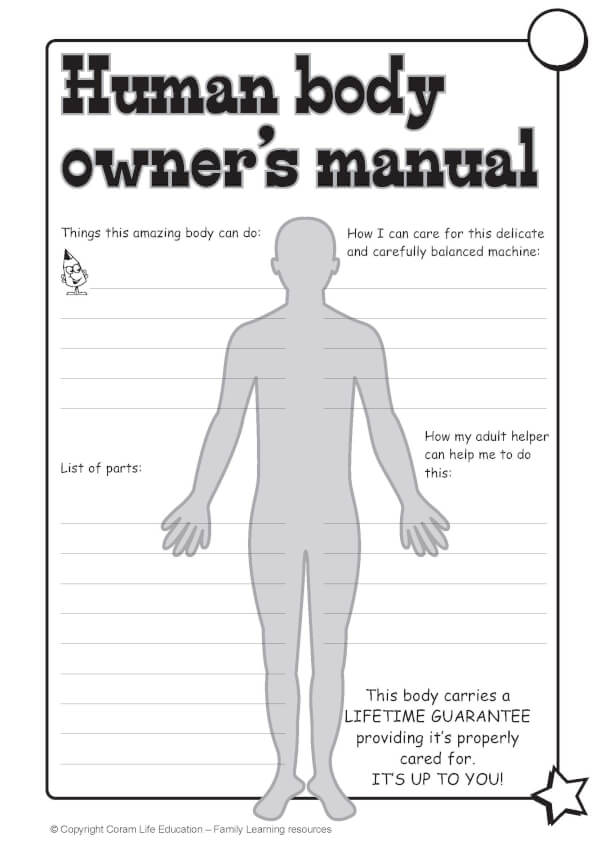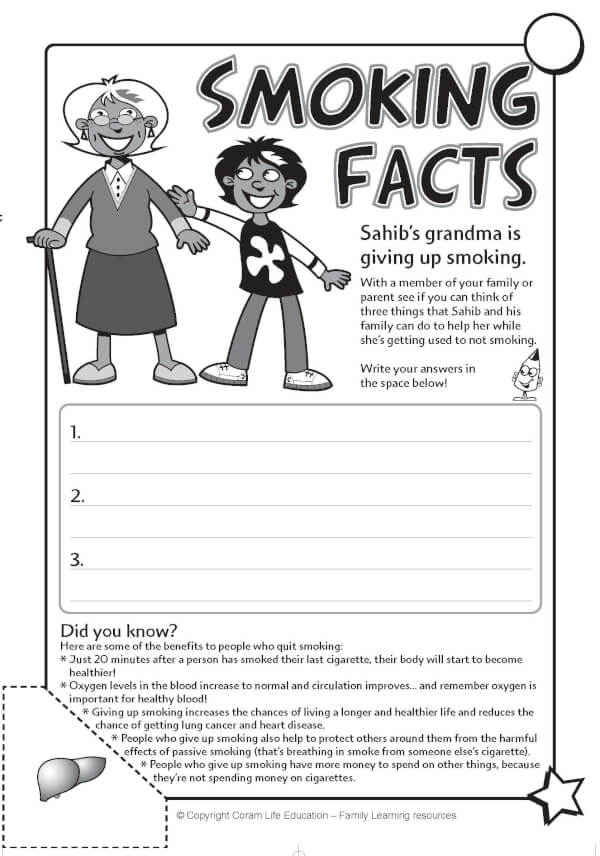SCARF at Home: Keeping Myself Safe - activities for 7-9 year-olds
What your child will be learning about
- Choices that affect our health
- Reasons why someone might choose to give up (or not start) smoking
- Pictures that are safe/unsafe to share online and tips for safe sharing
What your child can think about - or for you to talk about, together
- Some of the amazing things that the human body can do.
- Choices that can help the human body to stay healthy and safe.
- What have I heard about smoking and how it affects the body?
- How can I make sure that the images I am sharing are safe for me and others?
What your child can do - together with you, or independently
Activity 1- Human Body User's Manual
Your body is amazing! Just think of all the brilliant things it can do. Close your eyes and make a list in your head of 5 things that your body can do (balance, run etc.)
It’s important that we look after our bodies and try to keep them safe.
Print this activity sheet or copy down the headings then write down your ideas.

Click on the picture to make it bigger or to print it.
Can you share your ideas with a grown-up? How can they help you to keep your body in tip-top shape?
If you have a body book or you have access to the internet, you might like to find some amazing facts about the body part on your list. Remember - only search safe sites, e.g. BBC Bitesize has some great information!
Activity 2 - Smoking facts
At this time of the year lots of adults talk about ‘New Year’s Resolutions’. That means that they’re going to try to do something new or stop doing something. For a lot of people, it’s about making a healthy choice like doing more exercise or eating less of certain types of food. The following activity is about just that.

Click on the picture to make it bigger, or to print it.
Ask an adult to look at the activity with you. Remember that we can all make our own choices and we should try to respect the different choices that people make, even if we don’t agree with them.
Parent/carer notes to Activity 3 - Picture Wise
Sharing photos online is a fun and easy way to let our friends and family know what is happening in our lives. Photos can be shared through messages on mobile phones, emails, instant messaging, photo sharing websites and social networks.
Children need to understand that once a photo is posted online it can be copied (using a screenshot) and sent on to others.
Photos can be altered digitally to make fun of (usually in a very unkind way), ridicule or embarrass others.
A photo shared in a public forum online can be downloaded and viewed or used by anyone in the world.
Photos can be “geotagged” meaning that the exact location of the photo will be recorded and could be shared with others.
Photos are often “captioned” by the person who took the photo. Other people – friends, family and strangers, may also be able to comment about the photo or the caption. Children need to know that they should not reveal anything personal or private about themselves in the photo or in the caption that accompanies it.
Photos can be “tagged” on social networks. The “tag” identifies the name and identity of the person in the photo. It is good Cyber Ethics always to ask permission before “tagging” another person in a photo - or even just posting a picture of them without asking.
In the future, face recognition software may be capable of searching out photos of individuals from many web sites. This means that photos we post now may be accessible in the years to come. What we may consider funny or cute now may be embarrassing to us when we are older and applying for jobs etc..
If your child is a registered user of any photo sharing or social media sites, it’s a good idea to take this opportunity to examine their privacy settings.
For more help and advice, go to the NSPCC website's Keeping Children Safe page.
Activity 3 - Picture Wise
Sharing photos with family and friends is a great way to connect and keep in touch. We need to make sure that we’re keeping ourselves and others safe and that we’re being kind and respectful. We should always remember to think before we share.
Click on the Picture Wise activity, below, then follow the instructions to help you decide if it is ‘safe’ or ‘unsafe’ to share the image. Discuss the questions underneath with your parent or adult helper, if they're available.
Questions to discuss with your adult helper
- Who could this photo be shared with? Why?
- Who wouldn’t we share this photo with? Why?
- Would another person feel hurt, embarrassed or unsafe if this photo was posted to others e.g. friends, on online? Why?
- Is this photo safe to post on a public site? Why/Why not? E.g. does the photo show personal information such as the subject’s name, school or address from the photo?
- How could the photo be changed to make it safer? (e.g. not showing the logo on a school uniform, not showing street signs, not using “geo-tagging” options on the phone or camera setting.)
Activity 4 - None of your business
With a parent or adult helper, watch the film of Lee and Kim.
This film has been produced by CEOP - an organisation that helps to protect children from harm when using the internet.
Afterwards, discuss the following questions:
- Why did Super Sid turn up? [They were just about to tell the bear which school they go to}
- Why is this wrong? [It’s personal information which should never be shared online with people you don't properly know.]
- Why does Kim get butterflies in her tummy? [Nervous because she’s not sure about following the bear to the treasure as he asks lots of personal questions.]
What are Sid’s Top tips about staying safe online?
- People you don’t know are strangers, they are not always who they say they are.
- Be nice to people online, like you would be in the playground.
- Keep your personal information private, don’t give away secrets like where you live and the school you go to.
- If you ever get an ‘uh-oh’ feeling (like butterflies in the tummy), you should tell an adult you trust
You might like to make a poster of Picture Wise safety tips to display at home, or to show your teacher and class when you're back at school!

